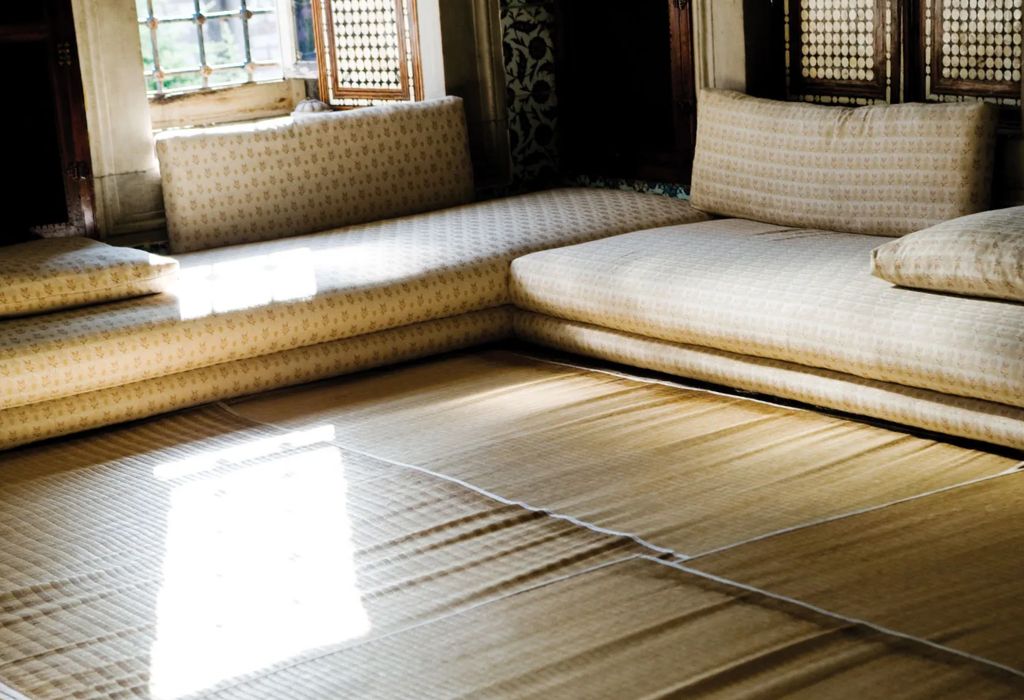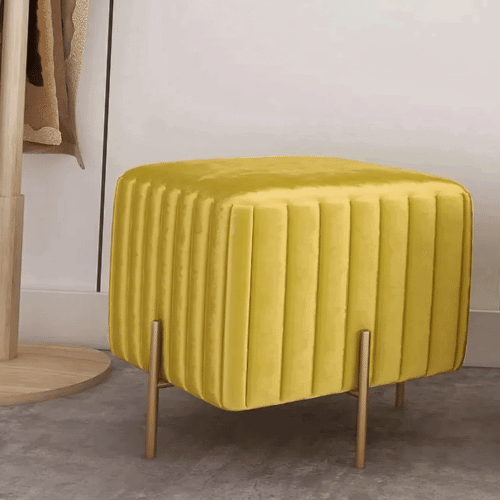
An ottoman is a padded seat or bench with storage space below and is traditionally used as a type of seating-cum-storage solution. Made from a variety of materials, from recycled velvet to jute, there’s an ottoman for every home out there, whatever its style.
Because of their storage capabilities, ottomans are perfect pieces for both compact living spaces and larger family homes, alike. In this blog, we’ll be giving a discerning overview of how you can incorporate an ottoman into your home decor scheme, as well as answering some of your other ottoman-related questions
Where Did the Ottoman Chair Come From?
Ottomans were first introduced into Europe from Turkey (the heart of the Ottoman Empire, hence the name) in the late 18th century.
Originally they were raised platforms strewn with cushions for seating Turkish families in comfort. They could be moved easily if a different configuration was needed. Essentially, they provided sectional seating without backs and arms and were designed to sit against three walls.
Eventually, however, the concept was scaled down to a smaller version that could fit into one corner instead of three.
Ottoman Furniture Name Origin
The name Ottoman refers to the place where this type of furniture originated-in particular Turkey – which was part of the Ottoman empire.
The Ottoman Empire was one of the most powerful and longest-lasting dynasties in history. This Islamic-run superpower ruled large areas of the Middle East, Eastern Europe and North Africa for more than 600 years and only fell in 1923.
Although the term ottoman originally related to a chair or stool, we now call beds and poufs ‘ottomans’, too – usually referring to the fact that the item has padded storage built in.
How Ottomans Have Evolved Over Time

When ottomans were first brought to Europe they graced both private, high-class saloons and public restaurants. They began to utilize hexagonal shapes or a circular seat surrounding a central column. Then, a hinged lid began to be incorporated giving useful storage space within too and so we started to approach something more akin to the modern ottoman.
Today, most of us think of an ottoman as being a smaller piece like a footstool, pouf or hassock. And whilst they’re certainly used for this, they can also be used for so much more.
Uses of an Ottoman
What is the Use of Ottoman in the Living Room?
Ottomans have multiple uses all over the home including bedroom and hallway. In the living room, for instance, an ottoman can be used as a cocktail table substitute, a decorative footstool for a sofa, or as space-saving storage.



Can You Sit on an Ottoman?
Yes you certainly can sit on an ottoman! They’re made to bear weight and offer handy additional seating options when you have guests over.
Can I Use an Ottoman as a Coffee Table?

Yes, an ottoman can absolutely be used in this way. Place it between your seating arrangement to mimic a coffee table. You can buy ottomans in many sizes to ensure that you get a perfect fit for your space. To preserve the cleanliness of your ottoman, You might want to invest in one upholstered with a wipeable fabric, or simply use a tray on top.
What is an Ottoman Used For in the Bedroom?

In the bedroom an ottoman can be used as a bedside table, occasional seating option or even as a blanket box. Place your ottoman at the foot of the bed to provide an additional element of comfort and add the finishing touches to your bedroom decor. In a child’s room, they make excellent toy chests.
Should an Ottoman Match the Couch or Chair?


An ottoman can match the couch or chair for a seriously sophisticated look. Equally, though, a contrasting or even mismatched ottoman can also look striking, giving a stark and bold aesthetic to your living space. You can also pair almost any ottoman and chairs together.
You can use a contrasting color as in the photo above. Brown Ottomans seem to go well with a wide range of colours and decors, although it’s not everyones preference to have a brown ottoman, it might be worth taking a look at our 10 best brown Ottoman coffee table ideas.
What Do You Store Inside an Ottoman?

The beauty of an ottoman is that you can store anything you like within them. A small stool makes an excellent sewing, crochet or embroidery store. Alternatively, you can use it to hide away those essential (but not aesthetically-pleasing) items like your remote control and phone charger. Larger ottomans can also be used to hold blankets or children’s dress-up clothes.
Should the Ottoman Be Lower Than the Sofa?
If you’re using an ottoman as a footrest, then ensure it’s about an inch lower than the height of your couch or chair. You don’t want your feet going uphill or too far downhill. Here’s a rough guide for the height of your ottoman, depending on the function of your ottoman.
- Foot Stool: 11″-15″
- Seating: 15″-18″
- Coffee Table: 16″-20″
- Storage: 15″-20″

How Big Should an Ottoman Be?
The size of your ottoman should depend upon what you’re using it for. Like any piece of furniture it needs to be in balance with your sofa, chairs and side tables. It also depends on the floor space you have available to you. However, ottomans have multiple uses, they can serve as a useful piece if you live in a small space.
A larger ottoman would also give more seating, but crucially, storage too. If your ottoman is being used as a coffee table, then aim for roughly two thirds of the length of your sofa or sectional and between 15 and 22 inches high. As ottomans can be used anywhere in your house you may find a narrow one goes well in the hallway as a useful place to put shoes.

Types of Ottoman
When it comes to the types of furniture now falling under the title ‘ottoman’, there’s a huge variety. The original design has evolved into all sorts of shapes, designs and materials, with many fulfilling different functions. We‘ve detailed the most common below:
1. Ottoman Bench
A wonderfully stylish and versatile piece that can have storage or not. They look great at the end of the bed, filled with spare blankets, or in front of your sofa as a footrest or coffee table. Place one in your hall and it can serve as a great spot to place your bags, or as somewhere for you to sit whilst you remove your shoes.
These benches come in many finishes – velvet, tufted cottons and tapestry to name but a few. They will generally all have a padded top meaning that they can also double up as extra seating. They’re easy to style, too. Just toss a toning throw over it and a couple of glossy mags and you’re good to go.
2. Ottoman Footstool
Ottomans are popular footstool choices given their high degree of comfort. If you choose one with storage, then it’s also an excellent place to keep your knitting, embroidery or magazines. They come in all shapes and sizes and can double up as seating around a low coffee table too.
Ottomans are popular footstool choices given their high degree of comfort. If you choose one with storage, then it’s also an excellent place to keep your knitting, embroidery or magazines. They come in all shapes and sizes and can double up as seating around a low coffee table too.
3. Ottoman Stool
Stools in this style are termed ‘ottoman’ as they, too, were popular back during the times of the ottoman empire. The curved shape resembles that of a saddle. They make a pleasing addition to a bedroom or as an occasional seat in a hallway. These stools don’t tend to have storage built-in as standard.
Ottoman Coffee Table

An ottoman makes a great coffee table being both stylish and practical. Although they’re padded they also tend to be quite firm, too, meaning that placing drinks on top isn’t going to place them at risk. The benefit of coffee table ottomans is that if you’re having lots of guests over, then you can move it from the center of the room and have it serve as additional seating. A super chic way of styling your ottoman coffee table is to top it with a tray; this will also reduce the risk of your ottoman’s fabric being stained in the event of spillages.
Ottoman Bed
An ottoman bed typically incorporates both sumptuous padding and storage space, making it a popular choice for many of us. There’s a huge variety of colors to choose from, so if you’re wanting to make a big statement in the bedroom, then look no further. The storage always comes in handy, whether it’s your holiday suitcases or your non-seasonal clothes, ensuring that they’re safely stashed away.
If you want to emulate this designer look bed, then try placing two padded ottomans side by side as a headboard.
Ottoman Storage
Many ottomans come with storage, showing that storage solutions don’t have to be dull, as you really can buy ottomans in virtually any design you can think of! You can even commission an upholsterer to match your ottoman to your cushion or curtain fabric. Here at Mini Home Deco, we love this on-trend leopard print one from La Redoute
Vanity Stool
If you’re looking for a pretty stool for your dressing table or vanity stand, then an ottoman is a great choice. Again, they come in so many colors and materials that you’re bound to find one that fits your space. They’re comfortable to sit on as well as being super stylish. If you buy one with storage, then it’s also a great place to keep all your nail varnish or your hair dryer.
Final Thoughts…
Hopefully, you’ll now feel more confident in shopping for an ottoman – whether it’s a bed, footstool or coffee table. Remember, though, to shop around and look out for great bargains at sale time. It’s worth investing in a quality piece as they will last a long time and keep their handsome Eastern looks.
Our Designer

Kasia Nowicka - ShowMeDesign
This blog was written in collaboration Kasia. Kasia has excellent space planning & conceptual designing skills. She has been an Interior Designer for 9+ years. In that time she has founded a highly successful in interior design business called ShowMeDesign.

Beste Yazici - Bx Design Studio Ltd
This blog was written in collaboration with Beste. She is a master interior architect and the owner of Bx Design Studio Ltd. Right now, she's giving interior design lectures at HDI Paris, and running her interior architecture and graphic design company, working on various international design projects.




















